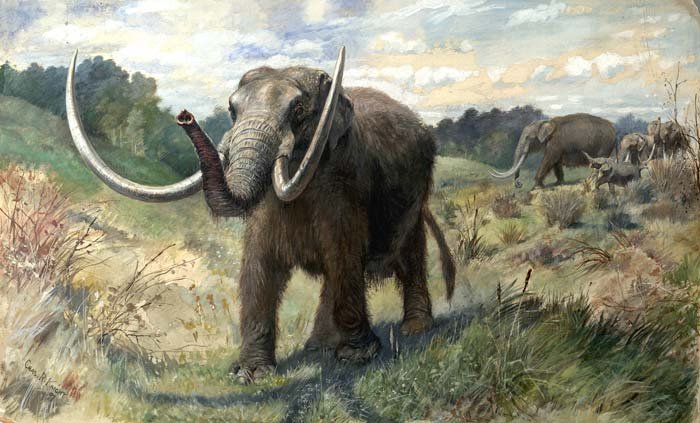9 November 2022
The mastodon is an extinct animal belonging to the genus Mammut and the order Proboscidea, which includes the mammoth and the present-day elephant. Mastodons ranged throughout North and Central America. They went extinct some 12,000 years ago, at the end of the Pleistocene era.
Mastodon is also the name of a social media platform similar in some respects to Twitter.
The name mastodonte was coined by French naturalist Georges Cuvier in 1806 from the Greek μαστός (mastos, breast) and ὀδούς (odous, tooth) because projections on the crowns of mastodon molars resemble nipples. The form mastodon appears in English by 1811. In those early years, the distinction between and classification of mammoths and mastodons were not firmly set, and it can be difficult to determine in writing from that era which of the present-day classifications those two words refer to.
The English word is borrowed from Cuvier’s French. Thomas Jefferson used mastodont in a 10 September 1809 letter to William Clark, of Lewis and Clark expedition fame:
the bones of this animal are now in such a state of evanescence as to render it important to save what we can of them. of those you had formerly sent me I reserved a very few for myself, got Doctr Wistar to select from the rest every piece [sic] which could be interesting to the Philosophical society, & sent the residue to the National institute of France. these have enabled them to decide that the animal was neither a Mammoth nor an elephant, but of a distinct kind, to which they have given the name of Mastodont, from the protuberances of it’s [sic] teeth. these from their form & the immense mass of their jaws, satisfy me this animal must have been arboriverous. nature seems not to have provided other food sufficient for him; & the limb of a tree would be no more to him than a bough of Cotton tree to a horse.
In 1811, paleontologist and surgeon James Parkinson, who was also the first to describe what we today call Parkinson’s disease, was among the first to use the form mastodon:
Walch, Wallerius and Gmelin, have supposed the fossil jaw found in the neighborhood of Bologna, De Monum. Diluv. In agro bonon. detecto, to have belonged to the walrus; but Cuvier has plainly shown, that it is the remains of a small species of the mammoth (Mastodon), as will be more particularly noticed in a succeeding letter.
I am unable to speak decidedly of a fossil tooth, said to be found in a bed of alluvial matters, in Norfolk. Its substance is very considerably changed: it is about fifteen inches in length, and appears to be nearly perfect at its extremities; although one side of it, and considerable portion of its internal substance is removed. The fineness of its grain and its edge not manifesting the peculiar lozenge-formed decussations observed in the ivory of the elephant and of the mammoth (Mastodon), with the size and form of the tooth, lead to the suspicion of its having belonged to an animal of this genus.
The social media service named Mastodon was launched on 5 October 2016 by its creator Eugen Rochko. He announced it on the site Hacker News:
Plans for the project: I'm a realist so I don't think that it will be able to compete with Twitter. However I would like this project to become the go-to option for people who are already inclined to prefer decentralized/self-hosted solutions, and simply be better than the other software in that space.
No, I don't plan to monetize. Mastodon is open-source, licensed under AGLPv3. However I do have a Patreon through which interested people could support me while I work on it.
The social media service gained widespread public attention in November 2022 after Elon Musk purchased Twitter and users of that service sought an alternative. Rochko’s choice of Mastodon as the name was apparently random. He commented on the name in Time in November 2022:
That got me thinking that, you know, being able to express myself online to my friends through short messages was actually very important to me, important also to the world, and that maybe it should not be in the hands of a single corporation that can just do whatever it wants with it. I started working on my own thing. I called it Mastodon because I’m not good at naming things. I just chose whatever came to my mind at the time. There was obviously no ambition of going big with it at the time.
Sources:
Conniff, Richard. “Mammoths and Mastodons: All American Monsters.” Smithsonian, April 2010.
Jefferson, Thomas. Letter to William Clark, 10 September 1809. The Papers of Thomas Jefferson Digital Edition, University of Virginia.
Oxford English Dictionary, third edition, March 2001, s.v. mastodon, n., mastodont, n. and adj.
Parkinson, James. “Letter 22. Fossil Remains of Mammalia.” Organic Remains of a Former World, vol. 3 of 3. London: Sherwood, Neely, and Jones, 1811, 310. Gale Primary Sources: Nineteenth Century Collections Online.
Perrigo, Billy. “Thousands Have Joined Mastodon Since Twitter Changed Hands.” Time, 6 November 2022 (updated 7 November 2022).
Rochko, Eugen (pseudonym Gagron). “Show HN: A New Decentralized Microblogging Platform.” Hacker News, 5 October 2016.
Image credits: Charles R. Knight, 1897. Wikimedia Commons. Public domain image; Rochko, Eugen, 2018, licensed under a GNU Affero General Public License.


